![[Siemens Brothers & Co., Ltd. houseflag]](../images/g/gb~hfsie.gif) image by Ivan
Sache, 30 April 2021
image by Ivan
Sache, 30 April 2021
Last modified: 2021-05-29 by rob raeside
Keywords: sheaf steam | shell | silver | map: africa | pg | sally | sfms | ws&co | handshake |
Links: FOTW homepage |
search |
disclaimer and copyright |
write us |
mirrors
![[Siemens Brothers & Co., Ltd. houseflag]](../images/g/gb~hfsie.gif) image by Ivan
Sache, 30 April 2021
image by Ivan
Sache, 30 April 2021
Wilhelm (Sir William) Siemens (1823-1884) went to England in 1843 on behalf
of his brother Werner (1816-1892) to sell the rights to Werner’s patented
gold-plating technique. A Siemens & Halske sales agency was established in 1850
under William’s direction, to be converted in 1858 into an independent company
known as Siemens, Halske & Co. with its own workshops. A cable factory was built
in Woolwich in 1863, while the company was renamed Siemens Brothers two years
later.
Siemens Brothers laid the Russia to Tehran section of the
Indo-European telegraph line in 1868-1869 and their first Atlantic Cable in
1873-1874. The cable steamer “Faraday” was built specially for this purpose.
Converted in 1880 into a stock company called Siemens Brothers & Co. Ltd., the
company had its shares confiscated by the English government in 1914;
re)-established on 1929, it was eventually acquired in 1958 by Associated
Electrical Industries Ltd. (A.E.T.).
https://www.britishtelephones.com/histsibr.htm
History of Siemens
Brothers
Cable steamer "Faraday" was built in 1874 by C. Mitchell &
Company Ltd., Newcastle on Tyne, and retired from cable service in 1923. The
"Faraday" was purpose-built for Siemens Brothers, incorporating many of William
Siemens' ideas, as he had found chartered vessels totally unsuitable for cable
laying.
In almost 50 years of cable work "Faraday" laid a total of 50,000 nm
of cable. The ship was retired in 1923 and sold in 1924 for scrap, but the 1"
thick plates defeated the breakers and so "Faraday" became a coal hulk, named "Analcoal",
at Algiers for the Anglo-Algiers Coaling Company. 1931 saw the hulk moved to
Gibraltar, still storing coal. In 1941 the vessel became a Naval store ship at
Sierra Leone. Towed back to England in 1950, she ended her days at a South Wales
breaker's yard.
The "Faraday" manufactured and laid in 1879 the second
French Atlantic cable for the Compagnie française du télégraphe de Paris à New
York. The cable stretched 2,242 nautical miles across the Atlantic from Deolen
(about 17 km west of Brest) to St. Pierre and 827 nautical miles from there to
Cape Cod, Massachusetts. The cable was landed at Cape Cod on 17 November 1879.
History of the Atlantic Cable & Undersea Communications
https://atlantic-cable.com/Cableships/Faraday/index.htm
Lloyd's Book
of House Flags and Funnels (1912) shows the house flag of Siemens Brothers &
Co., Ltd. (#1368, p. 102), as white with a red cross quartered by the black
letters "W", "W", "C" and "S".
https://research.mysticseaport.org/item/l011061/l011061-c008/#67
The
flag is shown of a stereoview of CS "Faraday", taken in 1874.
https://commons.wikimedia.org/wiki/File:CS_Faraday.jpg
The National
Maritime Museum keeps a copy of the flag
https://collections.rmg.co.uk/collections/objects/1033.html
Ivan Sache, 30 April 2021
 image
by Jarig Bakker,
based on the website of the National
Maritime Museum.
image
by Jarig Bakker,
based on the website of the National
Maritime Museum.
From the website of the National
Maritime Museum, the house flag of the Silver Line Ltd., London. A
rectangular blue and white triband with the word 'SILVER' in blue across the
centre stripe. The flag is made of a wool and synthetic fibre bunting. It has a
cotton hoist and is machine sewn."
Jarig Bakker, 28 August 2004
Silver Lines Ltd. Formed 1925 by Stanley & John Thompson Ltd. with early
sources showing the flag under their name. Most showed the bands as being equal
and some, principally
Talbot-Booth (1936) showed a silver band
with black letters. Harnack in his "Ships & Shipping" series showed both
versions in different sections. Talbot-Booth in 1942 noted that the silver
funnel had recently become white and at the same time, without comment changed
the flag band to white and lettering to blue.
Neale Rosanoski, 17 March 2005
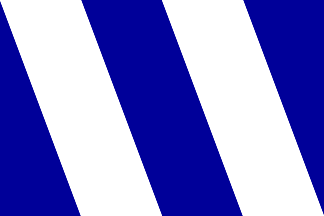 image
by António Martins-Tuválkin
image
by António Martins-Tuválkin
In 1956 the company amalgamated with and absorbed Dene Shipping Co. Ltd. and
apparently at first used their livery being a flag of 5 diagonal bands of blue
and white from upper hoist to lower fly which is
flown by the LJC liveries chart of
1966.
Neale Rosanoski, 17 March 2005
Loughran (1979) however shows a different version of 7 white and blue diagonal bands from lower hoist to upper fly. Whichever one of these was correct, and it was probably the LJC chart as its funnel showing bands sloping the same way as the flag is confirmed by ship photos, there was a further change to white with a panel of the LJC version flag between top and bottom further blue panels slightly separated by the field:
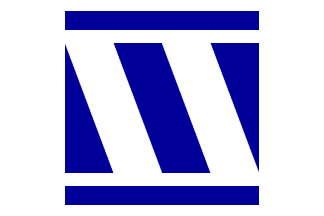 image
by António Martins-Tuválkin
image
by António Martins-Tuválkin
The
date of adoption is not known but it is noted in an article in the
February 1969 "Marine News" of the World Ship Society. The company
itself was taken over in 1974 as part of Shipping Industrial Holdings.
It disappearing from Lloyds Shipowners in the latter 1980s but
surfaced again a decade later as a subsidiary of the Vlasov Group (now
V. Ships Group). It has since disappeared again.
Neale Rosanoski, 17 March 2005
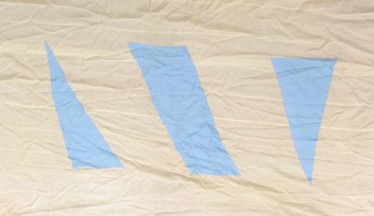 image from
B.J. Pullen, 24 October 2015 (cropped and flipped)
image from
B.J. Pullen, 24 October 2015 (cropped and flipped)
This flag was found in Plymouth. It has the word "HOUIE" written on the seam, but I cannot find any information about it.
B.J. Pullen, 24 October 2015
Apparently that design was adopted from Dene Shipping at the 1956 merger, and later it was changed to different versions. I agree that this one seems related, but since this flag has basically the same design, it
would more likely be older, and thus might be a Dene Line flag?
Peter Hans van den Muijzenberg, 21 February 2016
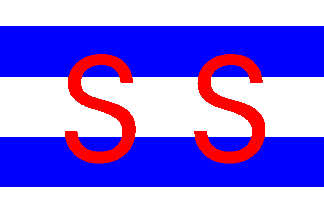 image
by Jarig Bakker, 29 December 2004
image
by Jarig Bakker, 29 December 2004
Silvertown Services Shipping Ltd., London - five horizontal stripes of white
and blue; red "SS".
From Scott, R.M., The Caltex book of Flags and Funnels, Capetown, Caltex Africa
Ltd. (1959).
Jarig Bakker, 29 December 2004
Silvertown Services Shipping Ltd. A Tate & Lyle short lived company which was
merged with an associate in 1963 to form Sugar Line Ltd. This version is
supported by a February 1969 Marine News article whereas Stewart 1963 shows the
flag bands being equal, as does
US Navy's 1961, but the latter shows what are
presumably meant to be silver bands instead of white.
Neale Rosanoski, 17 March 2005
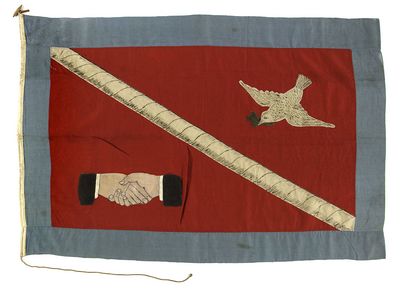 image
from
Port Cities
image
from
Port Cities
located by Jan Mertens, 7 February 2005, provided by London Borough Tower
Hamlets
Source:
https://collections.rmg.co.uk/collections/objects/1034.html
The house flag of the Silvertown Telegraph Works, a subsidiary of the India
Rubber, Gutta Percha and Telegraph Works Company. The parent company was founded
in 1852 by Samuel Winkworth Silver, who gave his name to the district on the
north bank of the Thames. The company stopped making telegraph equipment around
1930, and eventually became part of BTR Industries (formerly the British Tyre
and Rubber Company). This later merged with Siebe to become Invensys.
Jan Mertens,
7 February 2005
![[Skinningrove Iron Co. Ltd.]](../images/g/gb~hfsic.gif) image by Ivan Sache,
30 April 2021
image by Ivan Sache,
30 April 2021
Skinningrove steelworks was formed in 1874 as the Loftus Iron Company, after a
liquidation of the company reformed in 1880 as the Skinningrove Iron Company.
The works expanded from producing only pig iron to include steel production in
the early 20th century, with mills specialising in long products including
railway rail. As part of the business the company constructed a jetty at
Skinningrove, and owned an ironstone mine in Loftus.
The works existed as a
separate entity under the overall ownership of Pease and Partners bank until
nationalisation into the Iron and Steel Corporation of Great Britain in 1951,
returned to private ownership in 1963, and renationalised into British Steel
Corporation (BSC) in 1967.
Ownership as part of BSC passed to Corus Group plc
(1999), and to Tata Steel Europe (2006). In 2016, the long products division of
Tata Steel Europe including Skinningrove was sold to Greybull Capital.
https://en.wikipedia.org/wiki/Skinningrove_Steelworks
Wikipedia
Thomas Charles Hutchinson (1840-1918) commenced his business career in the
offices of the owners of the Middlesbrough estate. On the development of the
iron industry in the Cleveland district, and the erection of new plants, he
became connected with Messrs. Fox, Head & Co. at the Newport Rolling-Mills, and
superintended the laying out of the iron mills. He continued for about seventeen
years as commercial manager and left in 1880 to take up the managing
directorship of the Skinningrove Iron Company, the post which he held at the
time of his death.
At that time the plant of the Skinningrove Iron Company
consisted of two blast-furnaces which were not in operation, and it was not for
some time afterwards that they were working. In 1894 the plant was further
enlarged and close relationship was established with Messrs. Pease & Partners.
Two extra furnaces were built and later a fifth was added. Mines were also
started at Boulby to ensure the supply of ore. After visiting several works on
the Continent he formulated a scheme for the erection of steelworks and
coke-ovens in connection with the existing blast-furnace plant. About eleven
years ago he started building operations, and the extensions at the works
proceeded continuously up till the time of his death.
https://www.gracesguide.co.uk/Thomas_Charles_Hutchinson
Grace's Guide
Lloyd's Book of House Flags and Funnels (1912) shows the house flag of
Skinningrove Iron Co. Ltd. (#1358, p. 101), as white with the red letters
"S.I.C°L°.".
https://research.mysticseaport.org/item/l011061/l011061-c008/#66
Ivan
Sache, 30 April 2021
![[Ernest Sleighthouseflag]](../images/g/gb~hfesl.gif) image by Ivan Sache,
28 April 2021
image by Ivan Sache,
28 April 2021
Major Sir Ernest Sleight, Second Baronet, OBE, TD, DL, High Sheriff of
Lincolnshire, died in London yesterday.
Born on October 14 1873, eldest son
of the first baronet of Weelsby Hall, County Lincoln, a creation of 1920, he was
educated at Overslade, Rugby, and at Rugby School. For his services during the
1914-18 war, as a major in the 5th Battalion, The Lincolnshire Regiment, he was
made an OBE and later, he became honorary colonel of the 2nd Cadet Battalion of
his county regiment.
Sir Ernest Sleight, who succeeded to the baronetcy in
1921, was a director of steam fishing and other companies. In 1898 he married
Margaret, daughter of the late Mr C F Carter, of The Limes, Grimsby, and had two
sons and three daughters. His youngest daughter and younger son survive him. The
son, Mr John Frederick Sleight, who was born in 1909, married in 1942 Jacqueline
Margaret, eldest daughter of the late Major H R Carter of Brisbane, Queensland,
and widow of Mr R Mundell.
[The Times 17 July 1946]
Sir George
Frederick Sleight, Bt, of Weelsby Hall, near Grimsby, died on Saturday, aged 68.
He was the largest steam trawler owner in the world, and used to boast that he
started as a cockle gatherer. Formerly the principal smack [50 cockle smacks]
owner, he saw the possibilities of steam, and became a pioneer in effecting
change from the old to the new order, and was, in fact, the first merchant to
finance a privately owned steam trawler in Grimsby.
During the war, Sir
George lent the Government between 50 and 60 steamships. Over 30 boats were lost
by enemy action: but he purchased a number of obsolete ships and refitted them
to keep up the fish supply. Sir George was also an extensive farmer and
cattle-breeder, and bred a herd of the noted Lincolnshire red Shorthorns. He was
knighted in 1918, and two years later was raised to a baronetcy. he was married
in 1872, and had a family of four sons and three daughters. the eldest son,
Major Ernest Sleight, OBE, succeeds to the baronetcy.
[The Times 21 March
1921]
The fishing business of G F Sleight Ltd was taken over by Ross in
1956;
Ross had been established in 1918; Ross Group was formed in 1944, and
took over further fishing businesses; eventually in 1987, themselves being taken
over by British United Trawlers.
https://freepages.rootsweb.com/~treevecwll/family/sleights.htm
The
Acorn Archives - Hearts of Oak
Lloyd's Book of House Flags and Funnels
(1912) shows the house flag of Ernest Sleight (#1009, p. 85) as white with a
blue stripe on top and bottom and a red cross in the center.
https://research.mysticseaport.org/item/l011061/l011061-c008/50/
Ivan
Sache, 28 April 2021
![[George F. Sleight houseflag]](../images/g/gb~hfgfs.gif) image by Ivan Sache,
28 April 2021
image by Ivan Sache,
28 April 2021
Major Sir Ernest Sleight, Second Baronet, OBE, TD, DL, High Sheriff of
Lincolnshire, died in London yesterday.
Born on October 14 1873, eldest son
of the first baronet of Weelsby Hall, County Lincoln, a creation of 1920, he was
educated at Overslade, Rugby, and at Rugby School. For his services during the
1914-18 war, as a major in the 5th Battalion, The Lincolnshire Regiment, he was
made an OBE and later, he became honorary colonel of the 2nd Cadet Battalion of
his county regiment.
Sir Ernest Sleight, who succeeded to the baronetcy in
1921, was a director of steam fishing and other companies. In 1898 he married
Margaret, daughter of the late Mr C F Carter, of The Limes, Grimsby, and had two
sons and three daughters. His youngest daughter and younger son survive him. The
son, Mr John Frederick Sleight, who was born in 1909, married in 1942 Jacqueline
Margaret, eldest daughter of the late Major H R Carter of Brisbane, Queensland,
and widow of Mr R Mundell.
[The Times 17 July 1946]
Sir George
Frederick Sleight, Bt, of Weelsby Hall, near Grimsby, died on Saturday, aged 68.
He was the largest steam trawler owner in the world, and used to boast that he
started as a cockle gatherer. Formerly the principal smack [50 cockle smacks]
owner, he saw the possibilities of steam, and became a pioneer in effecting
change from the old to the new order, and was, in fact, the first merchant to
finance a privately owned steam trawler in Grimsby.
During the war, Sir
George lent the Government between 50 and 60 steamships. Over 30 boats were lost
by enemy action: but he purchased a number of obsolete ships and refitted them
to keep up the fish supply. Sir George was also an extensive farmer and
cattle-breeder, and bred a herd of the noted Lincolnshire red Shorthorns. He was
knighted in 1918, and two years later was raised to a baronetcy. he was married
in 1872, and had a family of four sons and three daughters. the eldest son,
Major Ernest Sleight, OBE, succeeds to the baronetcy.
[The Times 21 March
1921]
The fishing business of G F Sleight Ltd was taken over by Ross in
1956;
Ross had been established in 1918; Ross Group was formed in 1944, and
took over further fishing businesses; eventually in 1987, themselves being taken
over by British United Trawlers.
https://freepages.rootsweb.com/~treevecwll/family/sleights.htm
The
Acorn Archives - Hearts of Oak
Lloyd's Book of House Flags and Funnels
(1912) shows the house flag of George F. Sleight (#987, p. 83) as horizontally
divided blue-white blue.
https://research.mysticseaport.org/item/l011061/l011061-c008/48/
Ivan
Sache, 28 April 2021
![[Wm. Sloan & Co. houseflag]](../images/g/gb~wsc.gif) image by
Jarig Bakker,
based on the website of the National
Maritime Museum.
image by
Jarig Bakker,
based on the website of the National
Maritime Museum.
From the website of the National
Maritime Museum, the house flag of William Sloan and Co., Glasgow. A
rectangular blue flag with a white diamond bearing the red letters 'WS & Co'.
The flag is made of a wool and synthetic fibre bunting. It has a cotton hoist
and is machine sewn. A rope and toggle is attached."
Jarig Bakker, 4 September 2004
Wm. Sloan & Co. Originated 1825 as the St. Rollox Shipping Co. with sailing
vessels carrying chemicals for the works at St. Rollox which was operated by an
uncle of William Sloan. This company used a blue flag with the white letters "St.R"
over "Co.". I have no information on the formation of William Sloan & Co. though
it could have resulted from the advent of their 1st steamship in 1852 and
resulted in the first Sloan flag which was a blue pennant with the white letters
"W.S.Co" with the "o" being enhanced and the other letters being of equal
height. This flag was apparently also associated with the St. Rollox company,
presumably as managers. By Lloyds 1912 the Sampson flag is shown although Brown
1926 shows a blue pennant with the white letters "WS" but this, like the version
shown by the Journal of Commerce in their 1966 chart of blue with the white
letters "WS&Co", are probably incorrect.
Neale Rosanoski, 24 May 2004
Lloyd's Book of House Flags and Funnels (1912) shows the same house flag
(#478, p. 59).
https://research.mysticseaport.org/item/l011061/l011061-c008/#24
Ivan Sache, 24 April 2021
![[Sloan & Jacksonhouseflag]](../images/g/gb~hfslj.gif) image by Ivan
Sache, 3 May 2021
image by Ivan
Sache, 3 May 2021
Lloyd's Book of House Flags and Funnels (1912) shows the house flag of Sloan
& Jackson (#1622, p. 114), a Glasgow-based shipping company, as white with a
thin blue saltire, in the center a white oval bordered in blue and charged with
the red letters "SJ".
https://research.mysticseaport.org/item/l011061/l011061-c008/#79
Ivan
Sache, 3 May 2021
![[Thos. Smailes & Son houseflag]](../images/g/gb~hftsm.gif) image by Ivan
Sache, 25 April 2008
image by Ivan
Sache, 25 April 2008
Lloyds Book of House Flags and Funnels (1912)
shows the house flag of "Thos. Smailes & Son" (#310, p. 51), a company based in
Whitby, as blue with a white "S". The company disappeared at the end of the
First World War.
Ivan Sache, 25 April 2008
Thomas Smailes was born in January 1821. His father died in 1830, and in 1833
he was apprenticed to Seaton Trattles, first going to sea on the brig "Larpool",
aged 12. In 1842 he took command of the brig "British Oak", owned by Thomas
Turnbull and was subsequently master of several of Turnbull's ships and
superintendent of their fleet. His final command was as first master of Whitby's
first steamship, the "Whitehall", launched in 1871.
In 1890 the firm of
Thomas Smailes and Son was established to manage the shipping interests of
Thomas Smailes and his son Captain Richard Smailes. Thomas Smailes retired from
the company in 1901 and died in 1908.
https://discovery.nationalarchives.gov.uk/details/r/a35966fd-b51d-49a0-8602-d6ca016b4276
The National Archives
Ivan
Sache, 23 April 2021
![[Robert Thorman houseflag]](../images/g/gb~hfhsm.gif) image by Ivan Sache, 29 April 2021
image by Ivan Sache, 29 April 2021
Grimsby Town President in the 1880s, Henry Smethurst was better known locally
for almost fifty years’ public service as an Alderman and Liberal councillor.
After working in his father’s fish merchants, he went on to be a trawler owner
with interests in other fishing concerns in his own right. He died in 1923.
http://www.extra-gtfc.co.uk/accounts/chairman
Grimsby Town Football Club
plc
Lloyd's Book of House Flags and Funnels (1912) shows the house flag
of Henry Smethurst (#1100, p. 89) as blue with a white star.
https://research.mysticseaport.org/item/l011061/l011061-c008/#54
Ivan Sache, 29 April 2021
![[Sir William Reardon Smith & Sons Ltd. houseflag]](../images/g/gb~s0967.gif) image
by Phil Nelson, 11 April 2000
image
by Phil Nelson, 11 April 2000
from Stewart and Styring's Flags, Funnels and Hull Colors 1963
Sir W. Reardon Smith & Sons, Cardiff: red, a large black letter `S' (with
serifs) in the centre, taking up about one third of the flag's width and four
fifths of its height. Stewart and Styring's show
it as `Sir William Reardon Smith & Sons Ltd.', but letter without serifs; I
checked the on-line 1912 Lloyds Flags & Funnels and found this flag under No.
749 on p. 38 as `W.R.
Smith & Son, Cardiff" next to No. 750 (`P. Samuel & Son, Ltd., Cardiff'),
exactly the same but for the serifs. It must have been difficult to distinguish
between them unless you recognized the ships of course.
Jan Mertens, 4 June 2004
Captain William Reardon Smith established the business of the Reardon Smith Line
Ltd. as W.R. Smith and Son Ltd., at 124 Bute Street, Cardiff, and the Instow
Steamship Co. Ltd. in 1905 at Cardiff Docks.
The company had many subsidiary
and associated companies. The fleet of ships had grown to 39 ships by 1922. The
name changed to Reardon Smith Line Ltd. in 1928.
The company continued to
expand the fleet up to 1977. It also diversified into the chartering business
and oil extraction. In 1985 the group ceased trading and went into liquidation.
https://www.shipsnostalgia.com/threads/smiths-of-cardiff.5217/
ShipsNostalgia
Lloyd's Book of House Flags and Funnels (1912) shows the
house flag of W.R. Smith & Son (#749, p. 72) as red with a black "S".
https://research.mysticseaport.org/item/l011061/l011061-c008/37/
![[W.W.C. Smith & Co. houseflag]](../images/g/gb~hfwsm.gif) image by Ivan
Sache, 3 May 2021
image by Ivan
Sache, 3 May 2021
Lloyd's Book of House Flags and Funnels (1912) shows the house flag of W.W.C.
Smith & Co. (#1702, p. 118), a Glasgow-based shipping company, as
swallow-tailed, blue with a white lozenge charged in the center with a blue "S".
https://research.mysticseaport.org/item/l011061/l011061-c008/#83
Ivan
Sache, 3 May 2021